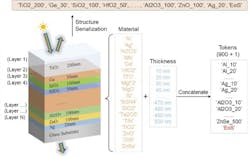OptoGPT harnesses AI to automate, speed design of optical structures
Researchers at the University of Michigan (U-M; Ann Arbor, MI) can now more accurately determine the optical properties needed to design better and more advanced devices with their development of OptoGPT, an optics-focused generative machine-learning framework (see video).
Their inverse design algorithm harnesses the neural networks behind OpenAI and ChatGPT—both increasingly popular generative artificial intelligence (GenAI) tools that enable human-like interaction in various ways.
“OptoGPT is motivated by the great success of GPT models in the natural language,” says L. Jay Guo, a professor of Electrical Engineering and Computer Science at U-M who helped develop the system.
OptoGPT is based on an architecture similar to ChatGPT. It uses the decoder of a powerful transformer model and generates the output in an auto-regressive way when given an input. OptoGPT harnesses the computer architecture behind ChatGPT to go from the optical properties needed to the material structure that provides them, Guo says.
How does it work? OptoGPT designs optical multilayer film structures (see figure)—layers of different materials—that can maximize light absorption in, for instance, a solar cell or a telescope. With extreme ultraviolet (EUV) light, it could also boost semiconductor manufacturing.
Guo explains the new framework essentially handles materials of a certain thickness as “words” and encodes their optical properties as inputs. It looks for correlations between “words” and can predict what’s next to create an artificial sentence. It can then design an optical multilayer film structure to meet the desired characteristics.
“We thought the GPT component of ChatGPT could possibly do the work because it's so powerful in handling large languages,” Guo says.
OptoGPT is trained on a large corpus of multilayer structures and their spectrums. It’s designed to inverse design multilayer structures when given proper optical targets as input.
These multilayer structures are stacked thin layers of different materials that can serve different purposes, including maximizing and enhancing the light absorption in solar cells or telescopes. They also have the potential for boosting development of smart windows by regulating glass temperature.
Design advantages
OptoGPT can design both material combinations and thickness for multilayer structures, and automatically terminates the design process when it thinks the designed structure can satisfy the desired performance.
The algorithm works extremely quickly, too, Guo says, noting it can finish each design process almost instantly, within just one second.
“When given one design target, it can output as many different structures as possible,” Guo says. “It is flexible and can incorporate any constraints into the design process.”
What’s next?
At this point, OptoGPT can only handle one-dimensional photonic structures. Guo’s team is working to extend the framework’s capabilities toward higher dimensions such as 2D metasurfaces.
“For example, periodic patterns, gratings, and so on,” Guo says. “And then move on to perhaps 3D, which is now heavily exploited in the metasurface.”
Another of the researchers’ objectives is to make OptoGPT simple to operate, more accessible, and require no specialized training. Similar to how ChatGPT works, a user could simply seek information to better understand different areas, components, etc. of optics technologies.
“You can ask essentially an expert system to tell you that information,” Guo says. “Once that’s accomplished in the optics domain, then we can branch into other scientific domains. OptoGPT enables researchers and engineers, who may not have sophisticated training in optics, to design optical multilayer film structures for a wide breadth of applications in a fast and convenient way.”
FURTHER READING
T. G. Ma, H. Z. Wang, and L. J. Guo, Opto-Electron. Adv., 7, 240062 (2024); https://doi.org/10.29026/oea.2024.240062.
About the Author
Justine Murphy
Multimedia Director, Digital Infrastructure
Justine Murphy is the multimedia director for Endeavor Business Media's Digital Infrastructure Group. She is a multiple award-winning writer and editor with more 20 years of experience in newspaper publishing as well as public relations, marketing, and communications. For nearly 10 years, she has covered all facets of the optics and photonics industry as an editor, writer, web news anchor, and podcast host for an internationally reaching magazine publishing company. Her work has earned accolades from the New England Press Association as well as the SIIA/Jesse H. Neal Awards. She received a B.A. from the Massachusetts College of Liberal Arts.

